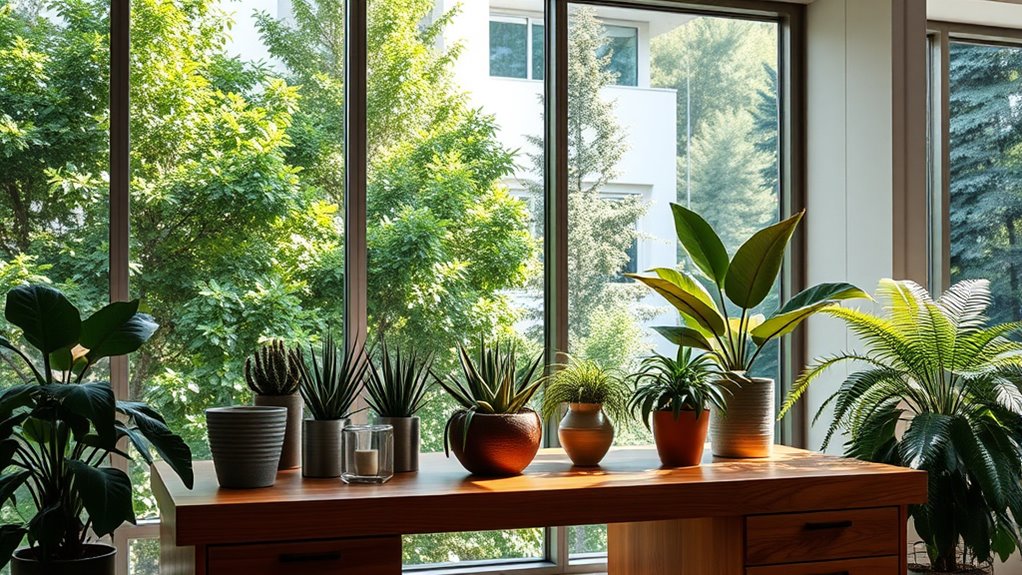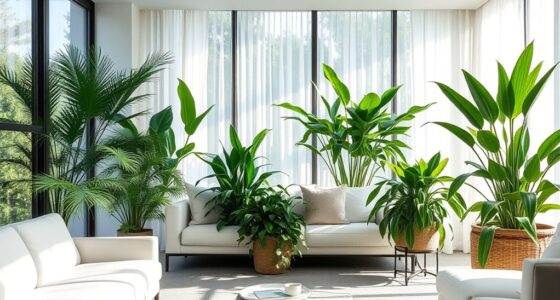Biophilic design uses natural elements like indoor plants to create healthier, more calming spaces that connect you to nature. By incorporating plants, you can boost your mood, reduce stress, and improve indoor air quality. They add texture, color, and a sense of vitality to your environment, making it feel more alive and balanced. Exploring how to strategically place and care for your plants can help you foster a stronger bond with nature indoors.
Key Takeaways
- Biophilic design integrates natural elements like indoor plants to enhance well-being and create calming, harmonious indoor environments.
- Indoor plants serve as living art, improving aesthetics, mood, focus, and air quality within designed spaces.
- Proper plant placement considers light, humidity, and space to maximize health benefits and visual impact.
- Incorporating plants fosters a deeper connection to nature, promoting mindfulness, responsibility, and emotional stability.
- Overall, biophilic design with indoor plants supports mental and physical health by transforming spaces into natural, revitalizing sanctuaries.

Biophilic design is transforming indoor spaces by seamlessly integrating natural elements, and indoor plants play a crucial role in this trend. When you introduce plants into your environment, you’re not just adding decor; you’re creating a tangible connection to nature that benefits your well-being. This approach emphasizes the importance of nature connection, making it possible to experience the calming and revitalizing effects of the outdoors from the comfort of your home or office. Plant integration becomes more than aesthetic—it’s a way to foster a sense of harmony and balance within your space.
Biophilic design seamlessly connects indoor spaces with nature through plants and natural elements.
As you incorporate indoor plants, you’re actively bridging the gap between indoor environments and the natural world. The presence of greenery influences your mood, reduces stress, and enhances focus. Plants serve as living art, bringing texture and color, but their true value lies in their ability to connect you with nature on a daily basis. This connection isn’t just visual; it’s tactile and atmospheric. When you touch the leaves or observe the way light filters through the foliage, you reinforce your bond with the natural environment. This direct interaction supports mental clarity and emotional stability, especially in urban settings where access to outdoor nature might be limited.
Plant integration in your space also improves air quality, which further deepens your connection to a healthier, more natural environment. Houseplants absorb toxins and release oxygen, creating a fresher indoor atmosphere. As you care for your plants, you develop a routine that fosters mindfulness and responsibility, reinforcing your role as a steward of nature. This act of nurturing enhances your sense of purpose and connection, making the indoor environment feel more alive and dynamic.
In practice, successful plant integration involves thoughtful placement and selection. You want your plants to thrive, so consider light, humidity, and space. Strategically placing plants near windows or in areas where you spend the most time maximizes their impact. Mixing different types of plants—succulents, ferns, or trailing vines—adds variety and texture, enriching your overall experience. The more you engage with your plants, the stronger your nature connection becomes, transforming your indoor space into a sanctuary that nurtures both your mental health and your physical environment.
Frequently Asked Questions
How Do Indoor Plants Improve Air Quality Beyond Aesthetics?
Indoor plants improve air quality by actively purifying the air and removing pollutants. They absorb carbon dioxide and release oxygen, enhancing overall air freshness. Additionally, plants filter out volatile organic compounds (VOCs) and other airborne toxins, reducing indoor pollution levels. By doing so, they create a healthier environment, making it easier for you to breathe and lowering the risk of allergies or respiratory issues caused by poor air quality.
Which Indoor Plants Are Best for Low-Light Environments?
You should choose shade tolerant plants like pothos, snake plants, or ZZ plants for low-light environments. These low light greenery options thrive without direct sunlight, making them perfect for darker corners or offices. They’re easy to care for and help bring nature indoors, improving your space’s ambiance. With their resilience, you’ll enjoy lush greenery even in areas with minimal natural light, creating a calming, natural atmosphere.
How Often Should Indoor Plants Be Watered for Optimal Health?
You should water your indoor plants when their top inch of soil feels dry, typically every 1-2 weeks. Stick to a consistent watering schedule to guarantee proper plant hydration, avoiding overwatering or underwatering. Check your plants regularly to gauge their needs, as factors like light, temperature, and plant type affect their water requirements. Proper watering helps your plants stay healthy, vibrant, and thriving in your indoor environment.
Can Biophilic Design Reduce Stress and Improve Productivity?
Yes, incorporating biophilic design can markedly reduce stress and boost your productivity. When you bring natural elements into your space, you create a calming environment that helps you feel more relaxed and focused. The presence of natural light, greenery, and organic textures encourages stress reduction and enhances your mental clarity. This connection to nature makes your workspace more inviting, ultimately helping you work more efficiently and with greater well-being.
What Are the Best Ways to Incorporate Plants Into Small Spaces?
You can maximize small spaces by trying vertical gardening or installing a plant wall. These options don’t take up much room and add vibrant greenery. If you think it’s complicated, don’t worry—many kits make setup easy. You’ll enjoy the benefits of lush plants without sacrificing space, making your environment more calming and inviting. Just choose the right plants and install them vertically for a stunning, space-efficient green upgrade.
Conclusion
So, next time you forget to water your indoor plants, just remember—you’re actually embracing biophilic design’s true spirit. Who knew that neglect could be part of bringing nature indoors? Your plants might not thrive, but at least you’ve added a touch of irony to your space. After all, isn’t the imperfect, lively chaos of neglected greenery what truly makes your home feel alive? Embrace the flaws; they’re just part of the design.









